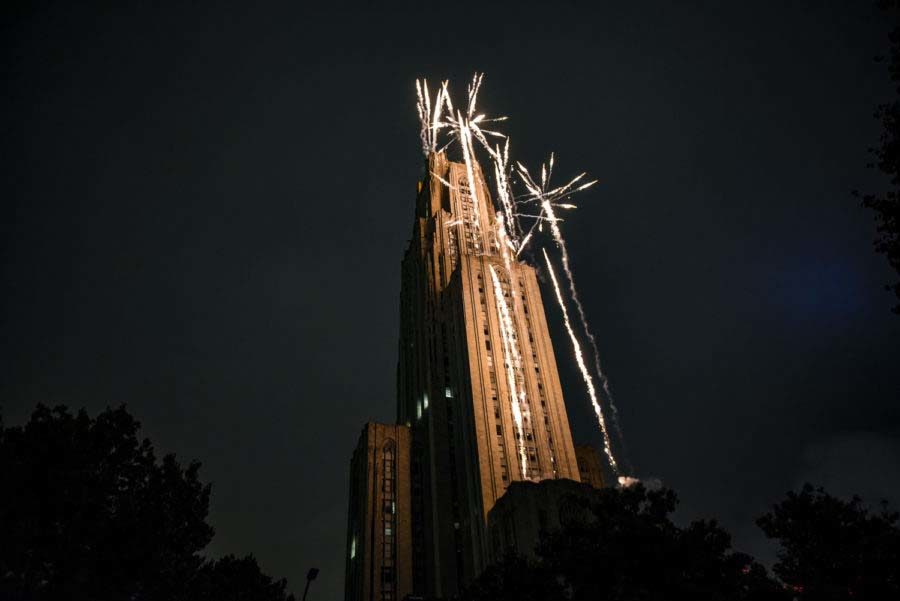Opinion | Believe it or not, homecoming isn’t obsolete
Knox Coulter | Assistant Visual Editor
Pitt has a Homecoming laser light and fireworks show every year for students and alumni.
October 24, 2019
As we make our way through homecoming season, Pitt students may recall their own high school homecomings, complete with pep rallies, dances and the quintessential homecoming football game. While some of these traditions hold true in college — take, for example, the annual homecoming football game — there is a noticeable difference between high school and college homecomings.
This difference can be fairly disillusioning to those students hoping for a formal dance or a University-wide spirit week. The absence of events typical of high school homecoming may leave students wondering exactly what the point of homecoming is in college. Apart from the window paintings in various campus buildings, homecoming spirit seems hard to come by. However, students should not be too quick to write off homecoming as a pointless or boring tradition.
Homecoming is a valuable tradition for college campuses because of the school spirit it promotes and the sense of unity and community it inspires on campus. Additionally, it provides alumni with an opportunity to revisit their alma mater and reminisce about their college years with the current student body.
Homecoming has roots in the early 1900s, when it was invented by either Baylor University, the University of Illinois or the University of Missouri. Though there is no definite consensus on which school truly originated the tradition, Missouri is typically credited with the first homecoming celebration. This original homecoming was held in 1911 when Missouri’s director of athletics, Chester Brewer, invited alumni to “come home” for a football game against their rival team. The game — which resulted in a tie — reportedly drew 10,000 alumni and fans back to their alma mater and was followed by a massive celebration with a pep rally, a bonfire and a parade.
Homecoming at Pitt doesn’t reach back quite as far as it does at Missouri — Pitt’s first homecoming was in 1928. However, the tradition is still alive and well. Pitt’s traditions have evolved from simple “smoking parties” — held in fraternity houses during the advent of Pitt’s homecoming — into the more elaborate celebration we have today, complete with alumni reunions, festivities before the football game and the annual light show and fireworks at the Cathedral of Learning.
This light show is actually an incredible testament to the importance of homecoming and its ability to draw people together. The show, held annually on the Friday preceding homecoming, draws a massive crowd to the Cathedral lawn and surrounding area as lasers dance in time to music and fireworks are shot off of the darkened Cathedral. It replaced Pitt’s homecoming parade in 1990, after the Pitt Program Council decided that there wasn’t enough space in Oakland to house flatbed trucks for students to make parade floats on, and it was too complicated to shut down the streets in Oakland for the parade to proceed through the neighborhood.
The evolution of Pitt’s homecoming celebrations over the years demonstrates the relevance of homecoming itself — if homecoming as an event were truly obsolete, it would not continue to exist and adapt with the times. However, this is not the case. Once popular traditions such as keg rolling races and including live animals in the homecoming parade have made way for the traditions we have today, demonstrating homecoming’s ability to change to suit the current student body and the surrounding community.
Homecoming is also a worthwhile and memorable event for alumni as it gives them an occasion to revisit campus revel in the nostalgia of their glory days. Considering that alumni spent four or more years on campus as well as thousands upon thousands of tuition dollars, it makes sense that they would want to find a chance to “come home” and see how Pitt has changed since their graduation.
Alumni also have a myriad of events to attend during this time of year, with numerous events hosted by the Pitt Alumni Association and the African-American Alumni Council as well as other on-campus organizations who seek to welcome alumni back to Pitt and encourage them to reconnect with their history here. This year, the schedule includes several class reunions, luncheons and the creation of a time capsule by the AAAC.
With the increased presence of alumni on campus comes numerous opportunities for current students to make connections and learn more about the generations that came before them. Homecoming provides an opportunity for students to network with visiting alumni who were members of the same societies or clubs and have now moved into the professional world. This is an opportunity that is bypassed by those who choose not to participate — or at least look into — homecoming events. In both cases, the coming together of current students and alumni fosters school spirit, which in turn creates solidarity and unity.
This sense of unity is vital to today’s society, especially considering the lengths people go to in order to identify with any given group. Homecoming is an opportunity for the student body to look past these differences and simply embrace being Pitt students, past and present.








